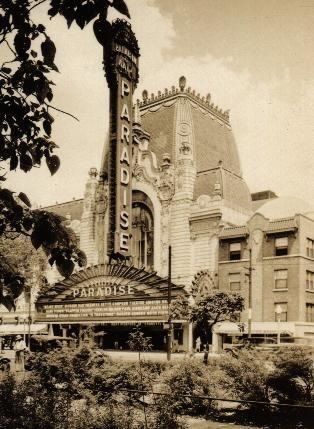Opened 1928 Destroyed by Demolition | Destruction date 1956 | |
 | ||
Similar Uptown Theatre, Uptown Theater, Grand Rex, Palace Theatre, Paramount Theatre Centre | ||
The Paradise Theatre was a movie palace located in Chicago's West Garfield Park neighborhood. Its address was 231 N. Crawford Avenue, Chicago, Illinois. Located near the intersection of West Madison Street and Crawford (now Pulaski Road) in the West Garfield Park area of Chicago's West Side.
Contents
History
The Paradise Theatre was built by the Balaban and Katz chain of movie theaters and opened on September 14, 1928. It was promoted as the world's most beautiful theater for its stunning interior and exterior beauty. It is regarded as one of the finest designs by architect John Eberson, as the sheer opulence and intricate craftsmanship that went into the theater made it a showpiece in and of itself. Unfortunately, flaws in the design (blamed on the vast domed ceiling in the over 3,500-seat auditorium) were exposed with the advent of talking pictures. Poor acoustics eventually cost the theater its attendance as neighborhood movie-goers would eventually turn to the nearby Mark Brothers showplace, the Marbro Theatre. As a result, business at the Paradise never recovered.
The Paradise Theatre's demise came in 1956, when Balaban and Katz closed the theater, demolished the building and sold the land to be developed as a supermarket. The theater that was "built to stand forever" almost lived up to that claim: what was estimated to have been a six-month demolition job ended up taking two years.
Organ
The Paradise Theatre was home to a large Wurlitzer theatre organ, catalog number Opus 1942. The organ console contained five manuals (keyboards), one of only three such instruments ever made by the Wurlitzer company. The organ, which had 21 ranks of pipes, was removed from the theater in 1948. It was installed in the Los Angeles home studio of Richard Vaughn, an executive at the Hi-Fi Records label. The organ was utilized by Hi-Fi to record a series of noted stereo record albums in the 1950s featuring organist George Wright. In 1969 the instrument was reinstalled in the Phoenix, Arizona home of William Brown. Brown enlarged the organ to 34 ranks. Since 2007, the organ has been in storage in Phoenix.
Styx album
Despite having never been a terribly successful movie house, the Paradise Theatre continues to live on in popular culture. Some of its continued fame is due to the Chicago-based rock band Styx who featured the theater in their album Paradise Theatre. The record, which was recorded in 1980 at Pumpkin Studios in the Chicago suburb of Oak Lawn, was released on January 18, 1981. It became a Triple platinum, Billboard #1 hit album, with numerous number one hits to its name. Lead singer and keyboardist Dennis DeYoung described the concept album as a fictional account of Chicago's Paradise Theater from its opening to closing (and eventual abandonment), serving as a metaphor for America's changing times from the late 1970s into the 1980s. The theater on the album's cover art actually doesn't resemble the actual Paradise Theater, however, it resembles another Chicago golden age movie palace, the Granada Theatre.
